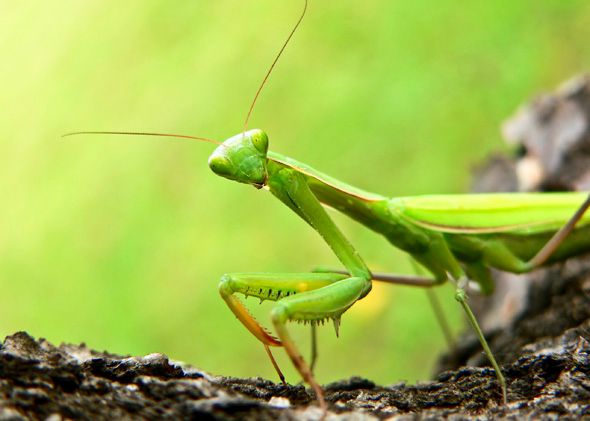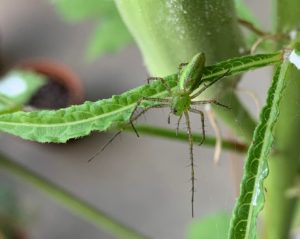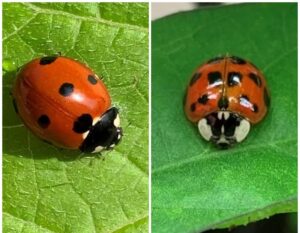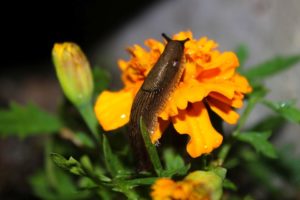Praying mantises are carnivores. It is no wonder that many gardeners consider them a free source of organic pest control. Their flexible necks enable them to turn their triangular heads from side to side while remaining stationary, giving them an advantage as they search for prey. In addition, their large, compound eyes can see in 3-D, which helps them visibly locate moving prey up to 50 to 60 feet (15 to 18 meters) away!
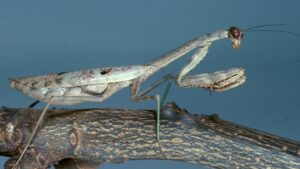
Agility and laser-focused vision are not the only things that helps mantises excel as insect hunters. Their forelegs are armed with rows of sharp spikes, which they skillfully use to capture and impale their prey. Praying mantises are also experts at blending in with their surroundings. Their green to mottled brown color provides them the perfect camouflage. (Learn more about praying mantises in this informative article.)
Unfortunately, these predators do not discriminate between harmful and beneficial insects. They are just as happy to munch on ladybugs, hoverflies, bees, butterflies, and lacewings as they are aphids, grasshoppers, roaches, and mosquitoes. Nevertheless, most gardeners are happy to see them.
If you are okay with their indiscriminate palate, you may be wondering how you can attract these amazing insects to your green space. While insects have a mind of their own when choosing a place to live, there are three things you can do to entice them to your garden: provide them the right type of shelter, hydration, and food.
Provide Shelter
Praying mantises need places where they can hide, not only so they can hunt stealthily but also to protect them from becoming prey themselves. Birds, snakes, lizards, spiders, and bats would love to make a meal out of these strange looking insects. Hiding places can include groundcover and low-growing plants like oregano and thyme, as well as shrubs like rosemary, juniper, boxwood, roses, and gardenias. The foliage and branches also provide the perfect environment for the females to deposit their eggs.
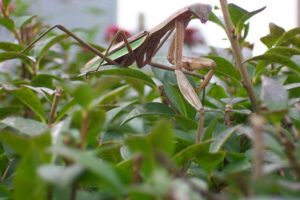
You might also want to plant raspberry canes, marigolds, cosmos, dill, fennel, yarrow, coneflowers, and caraway, as well as tall ornamental grasses. The upright flowers and strong stems can provide a camouflaged perch from which they can take command of the area. The mantises are not attracted to the flowers, per se, and will not eat them since they are carnivores (although some species are known to supplement their diet with pollen). The flowers will draw in insects that the mantises can eat.
Provide Water
We don’t often think about it, but insects of all kinds need hydration. An easy way to provide water for praying mantises and other insects is to set out a shallow dish filled with small rocks or pebbles. Add enough water so that it covers some but not all of the rocks. Mantises typically will only drink small droplets of water, so the partially submerged rocks will allow them a place to sit so they don’t fall in. The low amount of water will also discourage mosquitoes from choosing the dish as a breeding ground. Place the dish near shelter so it can be easily reached.
Provide Food
Praying mantises are no different than the rest of us. They like good food! One of the best ways to entice them to your garden is to ensure they have something to eat.
Mantises eat only living food. A partial list of their favorite foods includes aphids, beetles, caterpillars, grasshoppers, crickets, leafhoppers, wasps, hornets, moths, spiders, roaches, mosquitoes, and the larvae of the invasive and destructive spotted lantern fly. Remember, they will also eat bees, butterflies, and other beneficial insects. Large species of mantids, like the Chinese mantis, will eat small frogs, lizards, mice, and even hummingbirds, although these are rarer occurrences.
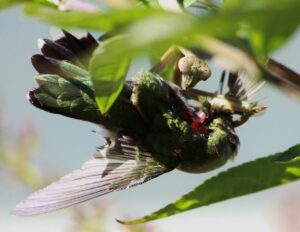
You can also make an artificial insect attractant by mixing one part sugar, one part yeast (brewer’s yeast or whey yeast) and ten parts water in a spray bottle. Shake well and spray your plants or place the mixture in a small, very shallow dish filled with pebbles. The mixture will attract insects which will, in turn, attract praying mantises.
Because mantises eat insects, you may need to refrain from using pesticides and insecticides, even organic ones, as they will deter, if not kill, the praying mantis and its food source.
This article contains affiliate links. If you make a purchase using one of these links, I will receive a very small commission at no additional cost to you, and it will help me maintain this website. Rest assured, I only recommend products I actually like!
Praying Mantis Egg Cases
Of course, it could be that your best efforts to draw these winged creatures to your garden falls short. If this is the case, you can purchase praying mantis oothecas (egg cases) online. An ootheca, which is Latin for egg container, is a ridged, beige to brown cocoon-like object. Some egg cases are longer and flatter than other, more spherical ones. The egg cases will likely come in a container filled with coco fiber or coir. Follow directions carefully to increase the chances of the eggs hatching successfully.
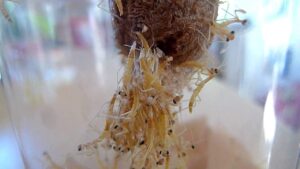
In nature, oothecas may be attached to branches, fence boards, or walls. If you find one, do not attempt to remove it. If it is attached to a branch, however, you can cut the branch and relocate it to a safe, sheltered place in your garden. The eggs will overwinter and hatch in the spring when the weather warms.
Praying mantises are truly fascinating insects. Hopefully, implementing these three tips will encourage them to make their home in your garden!
Thank you for reading this article! If you found it interesting or helpful, please consider sharing it with others via email and social media!
